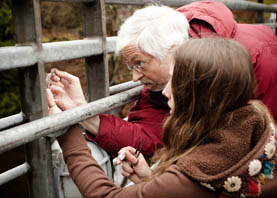
IRIS login | Reed College home Volume 90, No. 1: March 2011
Webmaster (continued)
“They do things in the most unlikely ways,” Black says. “For example, one species takes the body and cuts it in half and then migrates the left and right halves around the poles. To then call that a clever strategy—no one would characterize it that way, but it’s fascinating to see all these solutions to problems that the eggs face.”
If everything we know about the world tells us successful embryos develop in a certain way, what are we to make of creatures that develop in a completely different, yet equally successful, manner? What does this teach us about our understanding of development? These are the questions that the spiders raise—and that Black hopes to resolve.
![]()
Crystal Chaw, now a PhD student in integrative biology at the University of California, Berkeley, laughs when she recalls her battle to convince Black of the merits of spiders. “He had a hard and fast rule that he’d developed over the years at Reed—no independent projects that weren’t frog oriented.”
Eventually, he relented, and Crystal threw herself into the project, even working through Thanksgiving break. “It was one of the hardest, most frustrating things I’ve ever done,” she says. It also altered the trajectory of Black’s career.
That a tenured professor would have the subject of his research affected by a serendipitous encounter with a student is hardly unknown, according to former dean of the faculty Peter Steinberger. “Steve’s case is a perfect illustration of the interconnectedness of teaching and research at Reed,” he says, “Just as research deepens and enriches teaching, so does teaching inspire and provoke original inquiry. Indeed, these are two deeply intertwined and inseparable aspects of a single activity that defines Reed College—the activity of contributing to a high-level intellectual enterprise in which students play a crucial role.”
Crystal’s project yielded a key discovery. “Spider eggs are incredibly fragile,” Black notes. “And yet, because they essentially live in the air, the spider puts down an impervious coat around them to prevent them from drying out. So, we had to come up with a way to get through it without squashing the embryo inside . . . [Crystal] developed a killer fixative that works much, much better than any other fixative being used for spider embryos out in the world. It preserves their structure and freezes them in time so that you can look very carefully at where the cells are. It really transformed the work.”
Crystal also found that Zygiella x-notata, a species of spider living on the blue bridge spanning the canyon, is especially hardy, and produces eggs for much of the year—perfect for thesis students who need constant access to spider embryos.
As a few hardy pedestrians straggle past on a recent cold and bleak November afternoon, Black and student researcher Molly Radany ’11 venture to the blue bridge, bundled against the elements, looking for egg sacs. “This weather is brutal,” Black mutters as beads of mist gather on his jacket and hat. “I really don’t expect anything to be alive out here, but we need the eggs.”
Crouching down next to one of the bridge’s flickering blue lights, he peers intently at a strand of glistening web, brandishing a pair of tweezers. “Holy cow!” he exclaims, nimbly plucking several egg sacs from the web. “These guys are alive. Amazing. Really, they should all be dead by now, with this cold. There’s always more to learn.”
David Dalton, chair of the biology department, says this desire to learn has enabled Black and his students to make headway in a new field. “Steve found the unique and little-explored niche of spider development. He turned a few Reed students loose in this obscure world and let Reed creativity take over. Forget tradition—Reed students excel in setting new boundaries, and it turns out the spider world was a perfect outlet for Reed creativity.”
Several other students were instrumental in helping Black pursue spider development. Des Ramirez ’04, now a PhD student in evolutionary biology and neuroethology at the University of California, Santa Barbara, fondly recalls his work in Black’s lab. “Working on the spider project meant learning a lot of new skills, and a lot of trial and error. It was a real demonstration of the joys and frustrations of doing scientific research. I’ve actually found myself referring back to some of the techniques I learned then, both during my master’s and even now for my PhD.”
Meanwhile, Emily Vance ’05 brought her technological acumen to Black’s lab, allowing him to create high quality video images of embryonic development. “When Emily came in,” Black chuckles, “I was taking these transparency sheets and literally holding them up to the screen with the images of embryos and tracing them on to the transparency with a pen. She gave me this look like ‘Grandpa, that’s not how we do it,’ and converted the whole process to Photoshop.”
Emily, now a research assistant studying eye immunology at Oregon Health & Science University, recalls her early days as a thesis student in Black’s lab, saying, “I digitized his lab—my dad was a tech junkie, and that’s how I did things. I used Photoshop to go frame by frame and trace the cells. It was hard work, but I loved it.”
Indeed, if there is one refrain that Black’s students share, it is that work in his lab is difficult, demanding, and unquestionably rewarding. Black, in turn, points to the integral role students have played in moving his research forward. “The inherent difficulty in the originality of the work,” he says, “seems to have attracted a certain type of person, and they’re really dedicated to the operation of pushing the lab ahead. The students have been uniformly wonderful; they’ve been dedicated—it’s been fabulous, and I’ve felt like I’ve had a bunch of colleagues working with me, not students. The spider stuff has emerged entirely at Reed—the students have really done it all. It’s a perfect Reed story.”
![]()
When he first made the decision to leave salamanders behind and sally forth into the brave new world of spider development, Black realized that his lab was in dire need of additional resources. When it comes to support for new research, faculty often face a maddening Catch-22: you can’t get a grant without data, but you can’t gather data without a grant.
Fortunately, Reed was able to provide him with some crucial funding through a faculty development grant that was made possible by a larger grant from the Andrew W. Mellon Foundation.
The faculty development grant allowed Black to hire staff and to publish an article in Developmental Dynamics. With a peer-reviewed publication under his belt, Black was able to obtain additional funding from the M.J. Murdock Charitable Trust, a private foundation based in Vancouver, Washington, and the National Institutes of Health.



LATEST COMMENTS
steve-jobs-1976 I knew Steve Jobs when he was on the second floor of Quincy. (Fall...
Utnapishtim - 2 weeks ago
Prof. Mason Drukman [political science 1964–70] This is gold, pure gold. God bless, Prof. Drukman.
puredog - 1 month ago
virginia-davis-1965 Such a good friend & compatriot in the day of Satyricon...
czarchasm - 4 months ago
John Peara Baba 1990 John died of a broken heart from losing his mom and then his...
kodachrome - 7 months ago
Carol Sawyer 1962 Who wrote this obit? I'm writing something about Carol Sawyer...
MsLaurie Pepper - 8 months ago
William W. Wissman MAT 1969 ...and THREE sisters. Sabra, the oldest, Mary, the middle, and...
riclf - 10 months ago